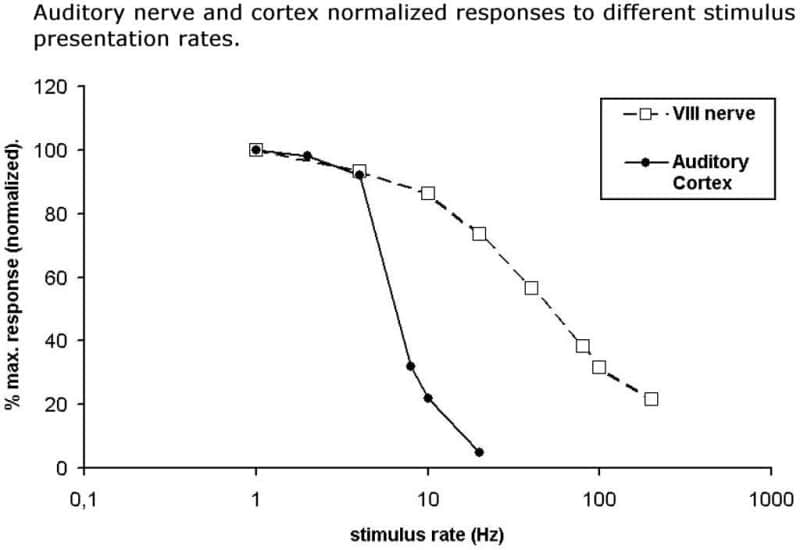Periodic sounds are commonly found in natural sources, speech and music. Therefore it is important to learn how neural responses change when exposed to stimulus sequences. We have studied the temporal properties of responses to auditory stimuli in the auditory nerve and cortex of the chinchilla. We recorded from 12 anaesthetised chinchillas (Ketamine 20 mg/kg IM, Acepromazine 0.7 mg/kg IM). At the end of the experiments the animals were euthanized (Thiopental 120 mg/Kg IV). Responses were recorded either with a round-window electrode positioned in the right cochlea (n=9), with tetrodes placed on the left auditory cortex (n=8), or simultaneously from round window and auditory cortex (n=5). Clicks and tones were digitally generated (TDT III), delivered through a closed cavity coupled to the ear, and presented at different rates (1 to 300 Hz) and sound pressure levels. Electrical responses were filtered, amplified (10,000x) and digitised with a NI® board. Auditory cortex units were sorted as described in Gray et al (1995). Auditory nerve compound action potential discharges followed stimulus presentation rates up to 300 Hz. These responses showed amplitude reductions and greater latencies for stimulus presentation rates higher than 50 Hz. Local field potentials recorded in the auditory cortex followed stimulus rates up to 20 Hz, while single units were able to follow stimulus frequencies up to 10 Hz. In a stimulus train preceded by five seconds of silence, the auditory nerve responses to the first stimulus in the train had the same amplitude and latency as responses to later stimuli, while cortical responses to the first stimulus of each train were stronger than those to later stimuli, with larger evoked potentials followed by an inhibitory period of about 500 ms. The mean first-spike latency to the first stimulus of cortical neurons was shorter than the mean first-spike latency to later stimuli(16.1±1.3 ms; 20.0±1.7 ms; means±SD, unpaired t test, p<0.01). The spike responses to the first stimuli showed an onset response followed by an inhibitory period of about 200 ms and a rebound that lasted to about 800 ms. These results support the claim that auditory cortex neurons have a lower 'cut-off' frequency than auditory nerve neurons, and also show auditory cortical properties to infrequent stimuli that had not been previously reported in the chinchilla.
King's College London (2005) J Physiol 565P, PC123
Communications: Simultaneous recordings from auditory nerve and cortex in chinchilla: temporal properties analysis
Delano, Paul ; Pavez, Elizabeth ; Elgueda, Diego ; Maldonado, Pedro E; Robles, Luis ;
1. Fisiologia y Biofisica. ICBM., Universidad de Chile, Santiago, RM, Chile.
View other abstracts by:
Fig 1. Auditory cortex responses can not follow stimulus rates higher than 10 Hz and decrease with a steep slope. Auditory nerve responses follow stimulus rates higher than 100 Hz.
Where applicable, experiments conform with Society ethical requirements.

